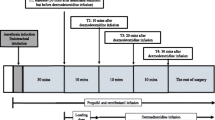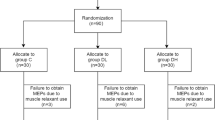Abstract
Background
Somatosensory-evoked potentials (SSEPs) are widely used for intraoperative spinal cord monitoring. Although many general anesthetics inhibit SSEPs, etomidate has been reported to boost SSEPs. This clinical study aimed to test whether etomidate doses less than 0.3 mg/kg amplify SSEP monitoring.
Methods
Patients were divided into four groups: A, B, C, and D. Etomidate doses of 0.1, 0.2, and 0.3 mg/kg were infused into patients in groups A, B, and C, respectively, after baseline SSEPs were obtained. Group D patients were infused with saline. In the subsequent 15 min, the amplitudes and latencies of SSEPs were recorded and compared.
Results
Etomidate exhibited amplification effects on SSEPs, and this effect increased with dose escalation. The amplitude changes in groups A, B, and C were significantly different (P = 0.002, P = 0.000, and P = 0.000, respectively) from that of group D. The amplitude change was largest in group C and significantly greater than those in groups A and B (P = 0.006, P = 0.000). Latency was not significantly affected (P < 0.05) by etomidate.
Conclusion
Small doses of etomidate that were less than 0.3 mg/kg had dose-related amplification effects on SSEP monitoring.


Similar content being viewed by others
References
Forster MT, Marquardt G, Seifert V et al (2012) Spinal cord tumor surgery–importance of continuous intraoperative neurophysiological monitoring after tumor resection. Spine(Phila Pa 1976) 37:E1001–E1008
Deletis V, Sala F (2008) Intraoperative neurophysiological monitoring of the spinal cord during spinal cord and spine surgery: a review focus on the corticospinal tracts. Clin Neurophysiol 119:248–264
Pajewski TN, Arlet V, Phillips LH (2007) Current approach on spinal cord monitoring: the point of view of the neurologist, the anesthesiologist and the spine surgeon. Eur Spine J 16:S115–S129
Nuwer M (2008) Intraoperative monitoring of neural function. In: Handbook of Clinical neurophysiology. New York, pp 94–126
Sloan T, Sloan H, Rogers J (2010) Nitrous oxide and isoflurane are synergistic with respect to amplitude and latency effects on sensory evoked potentials. J Clin Monit Comput 24:113–123
Peterson DO, Drummond JC, Todd MM (1986) Effects of halothane, enflurane, isoflurane, and nitrous oxide on somatosensory evoked potentials in humans. Anesthesiology 65:35–40
Koht A, Schütz W, Schmidt G et al (1988) Effects of etomidate, midazolam, and thiopental on median nerve somatosensory evoked potentials and the additive effects of fentanyl and nitrous oxide. Anesth Analg 67:435–441
Sloan TB, Ronai AK, Toleikis JR et al (1988) Improvement of intraoperative somatosensory evoked potentials by etomidate. Anesth Analg 67:582–585
Fengler BT (2008) Should etomidate be used for rapid-sequence intubation induction in critically ill septic patients? Am J Emerg Med 26:229–232
Sloan T, Rogers J (2009) Dose and timing effect of etomidate on motor evoked potentials elicited by transcranial electric or magnetic stimulation in the monkey and baboon. J Clin Monit Comput 23:253–261
Forman SA (2011) Clinical and molecular pharmacology of etomidate. Anesthesiology 114:695–707
Voss LJ, Sleigh JW, Barnard JP et al (2008) The howling cortex: seizures and general anesthetic drugs. Anesth Analg 107:1689–1703
Drexler B, Jurd R, Rudolph U et al (2009) Distinct actions of etomidate and propofol at beta3-containing gamma-aminobutyric acid type A receptors. Neuropharmacology 57:446–455
Lundy JB, Slane ML, Frizzi JD (2007) Acute adrenal insufficiency after a single dose of etomidate. J Intensive Care Med 22:111–117
Ray DC, McKeown DW (2007) Effect of induction agent on vasopressor and steroid use, and outcome in patients withseptic shock. Crit Care 11:R56
Aminmansour B, Khalili HA, Ahmadi J et al (2006) Effect of high-dose intravenous dexamethasone on postlumbar discectomy pain. Spine (Phila Pa 1976) 31:2415–2417
Markandaya M, Stein DM, Menaker J (2012) Acute treatment options for spinal cord injury. Curr Treat Options Neurol 14(2):175–187
Anschel DJ, Aherne A, Soto RG et al (2008) Successful intraoperative spinal cord monitoring during scoliosis surgery using a total intravenous anesthetic regimen including dexmedetomidine. J Clin Neurophysiol 25:56–61
Bala E, Sessler DI, Nair DR et al (2008) Motor and somatosensory evoked potentials are well maintained in patients given dexmedetomidine during spine surgery. Anesthesiology 109:417–425
Zaarour C, Engelhardt T, Strantzas S et al (2007) Effect of low-dose ketamine on voltage requirement for transcranial electrical motor evoked potentials in children. Spine (Phila Pa 1976) 32:E627–E630
Frei FJ, Ryhult SE, Duitmann E et al (2007) Intraoperative monitoring of motor-evoked potentials in children undergoing spinal surgery. Spine 32:911–917
Conflict of interest
The authors declare that they have no conflict of interest.
Author information
Authors and Affiliations
Corresponding author
Rights and permissions
About this article
Cite this article
Meng, XL., Wang, LW., Zhao, W. et al. Effects of different etomidate doses on intraoperative somatosensory-evoked potential monitoring. Ir J Med Sci 184, 799–803 (2015). https://doi.org/10.1007/s11845-014-1174-4
Received:
Accepted:
Published:
Issue Date:
DOI: https://doi.org/10.1007/s11845-014-1174-4




